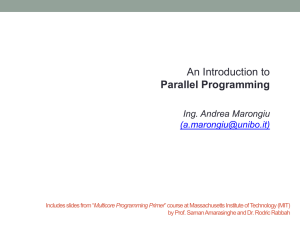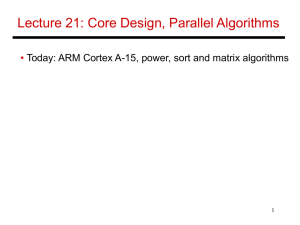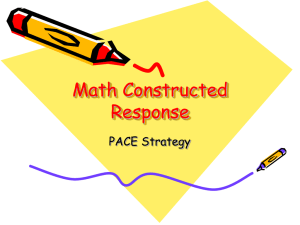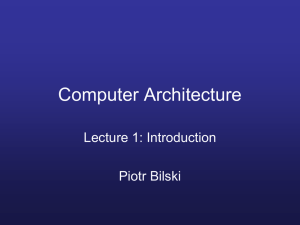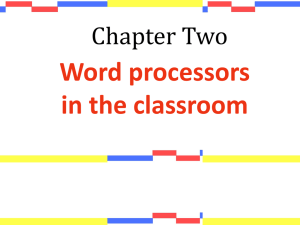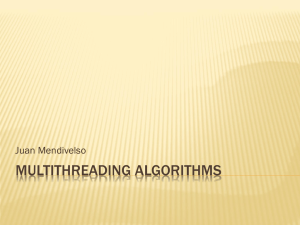High Performance Computing Lecture 1
advertisement
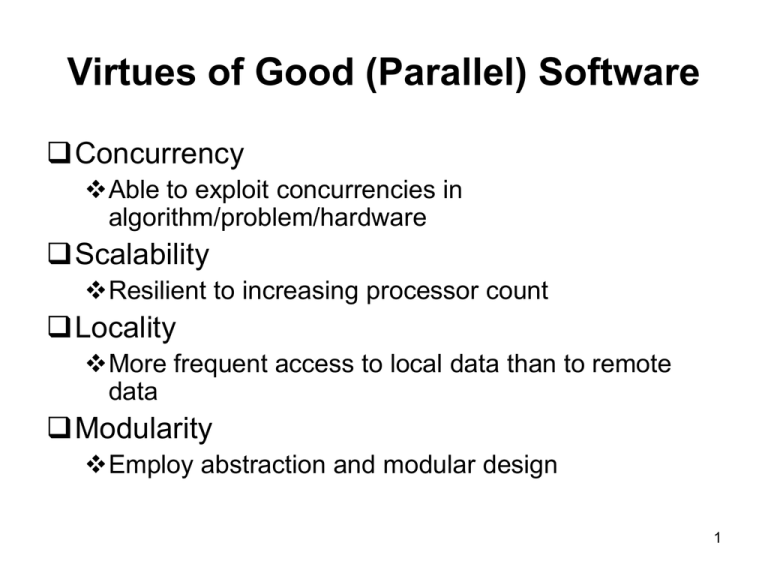
Virtues of Good (Parallel) Software Concurrency Able to exploit concurrencies in algorithm/problem/hardware Scalability Resilient to increasing processor count Locality More frequent access to local data than to remote data Modularity Employ abstraction and modular design 1 Two Basic Requirements for Parallel Program Safety: Produce correct results Result computed on P processors and on 1 processor must be IDENTICAL. Livelihood: Able to proceed and finish; free of deadlock. 2 Sources of Overhead Execution time The time that elapses from when the first processor starts executing on the problem to when the last processor completes execution Execution time = computation time + communication time + idle time Communication / interprocess interaction: usually main source of overhead T_comm = t_s + t_w*L Minimize the volume and frequency of communications; overlap computation/communication Idling: lack of computation or lack of data Load imbalance Synchronization Presence of serial components Wait on remote data Replicated Computation Communicate or replicate 3 Speedup & Efficiency Relative speed-up: the factor by which the execution time is reduced on multiple processors S(p) = T_1/T_p T_1 is the execution time on one processor T_p is execution time on p processors Absolute speed-up: where is T_1 is the uniprocessor time for best-known (sequential) algorithm S(p) <= p Embarrassingly parallel (EP): no communication among cpus. Superlinear speedup: exists in reality Efficiency: the fraction of time that processors spend doing useful work. E = S/p = T_1/(p*T_p) Parallel cost: p*T_p Parallel overhead: T_o = p*T_p – T_1 4 S Amdahl’s Law 1 1 P Alpha – fraction of operations in serial code that can be parallelized P – number of processors This is for a fixed problem size T_p = alpha*T_1/p + (1alpha)*T_1 S 1/(1-alpha) as Pinfinity Alpha = 90%, S10 Alpha =99%, S100 Alpha = 99.9%, S1000 “Mental block” 5 Gustafson’s Law S (1 ) P Alpha – fraction of time spent on parallel operations in the parallel program This is for a scaled problem size; or constant run time. T_1 = (1-alpha)*T_p + p*alpha*T_p As problem size increases, fraction of parallel operations increases 6 Iso-Efficiency Function For fixed problem size N, as P increases, increase in speedup S slows down or levels off, efficiency E decreases For fixed P, as the N increases, S increases, efficiency E increases As P increases, can increase the problem size N such that the efficiency is kept constant This N(p) for fixed efficiency is called iso-efficiency function Rate of increase in N(p), dN/dp, measures the scalability of a parallel program Smaller rate of increase more scalable 7 Parallel Program Design PCAM Model (I. Foster) Concurrency, scalability Locality, performance-related issues 8 Partitioning Decompose the computation to be performed and the data operated on by this computation into small tasks Purpose: expose opportunities of parallel execution Ignore practical issues such as number of processors in target machine etc Avoid replicating computation and data Focus: Define a large number of small tasks in order to yield a fine-grained decomposition of the problem Fine grained decomposition provides the greatest flexibility in terms of potential parallel algorithms Maximize concurrency 9 Partitioning Good partition: divides both the computation associated with a problem and the data this computation operates on Domain/Data decomposition: first focus on data Partition the data associated with the problem Associate computations with partitioned data Functional decomposition: first focus on computation Decompose computations to be performed Deal with data decomposed computations work on 10 Domain Decomposition Decompose the data first, and then associated computations “owner computes” Outcome: tasks comprising some data and a set of operations on that data Some operation may require data from several tasks communication Data can be input data, output data, intermediate data, or all of them. Rule of thumb: focus first on largest data structure or the data structure accessed most frequently Mesh-based problems: Structured mesh: 1D, 2D, 3D decompositions Unstructured mesh: graph partitioning tools such as METIS Favor the most aggressive decomposition possible at this stage 11 Functional Decomposition Focus first on computation to be performed; Divide computations into disjoint tasks Then consider the data associated with each sub-task Data requirements may be disjoint done Data may overlap significantly, communications; May just as well try domain decomposition Provide an alternative way of thinking about problem; Hybrid decomposition maybe best E.g. multi-physics simulations, overall functional decomposition, each component domain decomposition 12 Partitioning: Questions to Ask Does your partition define more tasks (an order of magnitude more?) than the number of processors of the target machine? No reduced flexibility in subsequent stages Does your partition avoid redundant computation and storage requirements? No may not be scalable to large problems Are tasks of comparable size? No hard to allocate to cpus with equal amount of work load imbalance Does the number of tasks scale with problem size? Ideal: increased problem size increase in number of tasks No may not be able to solve larger problems with more processors Have you identified alternative partitions? Maximize flexibility; try both domain and functional decompositions 13 Communication Purpose: Determine the interaction among tasks Distribute communication operations among many tasks Organize communication operations in a way that permits concurrent execution 4 categories of communications: Local/global communications: Local: each task communicates with a small set of other tasks (neighbors) Global: communicate with many or all other tasks 14 Communication Structured/un-structured communication Structured: A task and neighbors form a regular structure, grid or tree Un-structured: communication represented by arbitrary graphs Static/dynamic communication: Static: identity of communication partners does not change over time Dynamic: identity of partners determined by data computed at runtime and highly variable Synchronous/asynchronous communication Synchronous: requires coordination between communication partners Asynchronous: without cooperation 15 Task Dependency Graph Task dependencies: one task cannot start until some other task(s) finishes. E.g. the output of one task is the input to another task Represented by the task dependency graph: Directed acyclic Nodes: tasks (task size as the weight of node) Directed edges: dependencies among tasks 16 Task Dependency Graph Degree of concurrency: number of tasks that can run concurrently Maximum degree of concurrency: the maximum number of tasks that can be executed simultaneously at any given time Average degree of concurrency: the average number of tasks that can run concurrently over the duration of program Critical path: The longest vertex-weighted directed path between any pair of start and finish nodes Critical path length: sum of vertex weights along the critical path Average degree of concurrency = total amount of work / critical path length 17 Task Interaction Graph Even independent tasks may need to interact, e.g. sharing data Interaction graph: captures interaction patterns among tasks Nodes: tasks Edges: communications / interactions Example interaction graph Usually contains task dependency graph as sub-graph 18 Communication: Questions to Ask Do all tasks perform the same number of communication operations? Unbalanced communication poor scalability Distribute communications equitably Does each task communicate only with a small number of neighbors? May need to re-formulate global communication in terms of local communication structures Can communications proceed concurrently? Can computations associated with different tasks proceed concurrently? No may need to re-order computations / communications 19 Agglomeration Improve performance: Combine tasks to reduce the task interaction strength, increase locality, increase the computation and communication granularity. Also determine if it is worthwhile to replicate data/computation Dependent tasks will be combined Independent tasks may also be agglomerated to increase granularity Goals: reduce communication cost, retain flexibility w.r.t. scalability and mapping decisions 20 Increasing Granularity Coarse-grain usually performs better: Send less data (reduce volume of communication) Use fewer messages when sending same amount of data (reducing frequency of communications) Surface-to-volume effects: Communication cost usually proportional to surface area of domain Computation cost usually proportional to volume of domain As task size increases, amount of communication per unit computation decreases High-D decomposition usually more efficient than low-D decompositions, due to reduced surface area for a given volume. Replicate computation: May trade off replicated computation for reduced communication or execution time. 21 Agglomeration: Questions to Ask Has agglomeration reduced communication costs by increasing locality? If computation is replicated, have you verified that the benefits of replication out-weigh its costs for a range of problem size and processor counts? If data is replicated, have you verified that it does not comprise scalability Do the tasks have similar computation and communication costs after agglomeration? Load balance Does the number of tasks still scale with problem size? 22 Mapping Map tasks to processors or processes. If the number of tasks is larger than the number of processors, may need to place more than one task on a single processor Goal: minimize total execution time Place tasks that execute concurrently on different processors Place tasks that communicate frequently on the same processor In general case, no computationally tractable algorithm for the mapping problem, NPcomplete. If SPMD-style, one task per processor 23 Parallel Algorithm Models Data parallel model: processors perform similar operations on different data Work/task pool model (replicated workers): Pool of tasks, a number of processors A processor can remove a task from pool and work on it A processor may generate a new task during computation and add it to the pool Master-slave/manager-worker model: master processors generate work and allocate it to worker processors Pipeline/producer-consumer model: a stream of data passes through a succession of processors, each perform some task on it. Hybrid model: combination of two or more models 24


